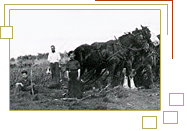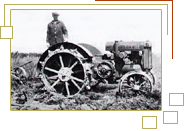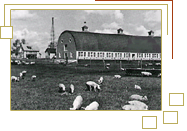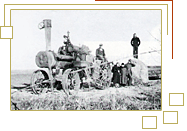|
 |
North Eastern Alberta Livestock Cooperative Association (N.E.A.L. CO-OP)
by L.O. Martin
Tilling the ground under, 1935
|
 |
Livestock producers during
the depression years of the 30's realized that something
had to be done to improve their bargaining position in the
market place. Other parts of the province had already made
progress in organizing co-op shipping yards. In St. Paul,
Alberta, the man to champion this cause in 1935 was Mr.
J.M. Fontaine. He was then the District agriculturist there.
Under his guidance, the above named association was formed
and an assembly yard was opened for business in 1936. Mr.
Fontaine supervised operations the first year. Other places
along the railway joined this association until 14 points
had assembly yards (one market day each week).
Ernest
Déry and Albert Demers, 1926
|
 |
In 1937, Mr. Zenon Joly was
appointed manager and secretary, also agent for the St.
Paul yard. His son André was hired to help handle
the heavy work load in 1954. Bonnyville joined the association
and opened for business in 1938. Mr. Armand Beauchêne
was the agent and with the able help of Charles Beaupré,
operated the yard for 2 years. Mr. Louis Martin replaced
C. Beaupré April 1st, 1940. After a short apprenticeship,
Mr. Martin was appointed agent, a position he held for over
32 years.
Many helpers worked at this co-op yard at different times.
To name a few: John Nowasad, Ernest Séguin, Lucien
Séguin, Ed Espetveidt and Albert Desilets. Emile
Déry worked with Mr. Martin for 21 years. He had
power of attorney and would operate the yard efficiently
whenever Mr. Martin was absent.
Pig
Farm, 1938
|
 |
Many carloads of cattle and
hogs were shipped from this yard: 1,000 or more hogs per
month in peak season. A record market day was when 73 members
delivered 398 hogs to the co-op yard here.
This Co-op association is a member of a central co-op named
Alberta Livestock Co-op (A.L.C.). They introduced the auction
method of selling cattle which was a big improvement over
the Private Treaty method employed before.
The Alberta Hog Producers Marketing Board was formed in
the 1960's and all Alberta hogs for slaughter are sold by
them. They use the teletype Dutch auction method. Cheques
are mailed by them directly to the producers. This reduced
our secretary's work by at least one half.
Mr. Joly Sr. resigned in 1970 after serving 33 years as
manager and secretary of our association. His son, André
Joly carried on as manager secretary.
In 1969, a Livestock Auction Market opened in Bonnyville.
This was an asset for this area, it provided a shorter link
between producer and the ultimate buyer. Even though freighting
by truck was more expensive than by rail, as roads improved,
so too did the level of service offered by the trucks. Trucks
could load livestock at the farms and deliver to the destination
without delay. The smaller yards were bypassed and closed
their doors one by one.
Mr.
Émile Baril's steam engine
|
 |
The records show that just
9 yards were in operation in 1970, shipping 34,790 hogs
while Bonnyville yard accounted for 7,302. Alex Lavigne
became agent in 1973.
At this time of writing, March 1982, only St Paul and Elk Point are still assembling hogs under the name of N.E.A.L. Co-op. Bonnyville yard closed in 1975. Much was accomplished, much remains to be done.
|
 |
|